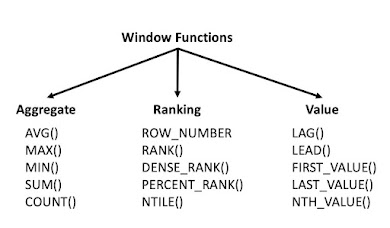SQL Window Functions
The SQL window functions are also frequently used in everyday work by data scientists and data analysts, especially when querying particularly large datasets. Their usage can not only make the SQL code faster but also clearer and easier to understand by others. However, because of the complicated syntax, arguably less intuitive than with other SQL constructions, it takes practice to master using SQL window functions in queries.
The aggregate functions, you know that already, take values from multiple rows and return one value. Yes, this is data aggregation. The most popular aggregate functions are SUM(), COUNT(), AVG(), MIN(), and MAX().They are often used in the GROUP BY clause. That way, data can be aggregated on multiple columns, which extends the aggregate functions’ analytical possibilities. They still don’t retain the individual rows that are the basis for aggregation.Formally speaking, window functions use values from multiple rows to produce values for each row separately and retain the individual rows. What distinguishes window from other SQL functions, namely aggregate and scalar functions, is the keyword OVER, used to define a portion of rows the function should consider as inputs to produce an output. This portion of rows is called a ‘window’, hence the name of this family of functions.
List of SQL Window Functions
The main characteristic of the aggregate window functions is that they reuse the existing simple aggregate functions (such as COUNT() or SUM()) while changing the way in which the aggregation is defined and the format of the results. Meanwhile, the built-in functions have new names and cannot be used in another context.
The built-in SQL window functions are then sometimes divided into two different types: the ranking and value functions. The ranking window functions are used to simply assign numbers to the existing rows according to some requirements. On the other hand, the value window functions are used to copy values from other rows to other rows within the defined windows.
So they are broadly divided into three categories:
• Aggregate Window Functions
• Ranking Window Functions
• Value Window Function
1. Exploring the Dataset
The interview questions usually have a concrete dataset you should
use to come up with a solution. The data is set up in a way that it tests certain SQL concepts. Always take some time to get to know the data types and inspect data for duplicates, NULL values, or missing values. This all influences your code and the functions you have to use. If there is more than one table, inspect how the tables are interconnected, how you could join them, and which JOIN you should use.



.jpg)

No comments:
Post a Comment